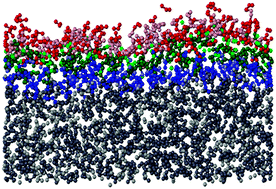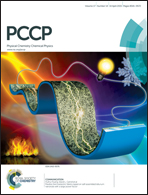Properties of the liquid–vapor interface of acetone–methanol mixtures, as seen from computer simulation and ITIM surface analysis
Abstract
Molecular dynamics simulations of the liquid–vapor interface of acetone–methanol mixtures of different compositions, including the two neat systems, have been performed on the canonical (N,V,T) ensemble at 293 K. The intrinsic liquid surface has been determined in terms of the Identification of the Truly Interfacial Molecules (ITIM) method. The results have revealed that the proximity of the interface influences the properties of only the first molecular layer of the liquid phase, while the second layer already turns out to be bulk-like in every respect. The two molecules are distributed uniformly along the macroscopic surface normal axis, as no strong preference for surface adsorption is shown by any of them. However, similarly to the bulk liquid phase, both molecules exhibit a marked tendency for self-association within the surface layer. Surface orientations are found to be composition independent; all the preferred orientations of both molecules correspond to the same alignment of the molecular dipole vector, which is nearly parallel to the macroscopic surface plane, declining only 10–20° from it towards the vapor phase. The surface properties are thus primarily governed by dipolar interactions, whereas hydrogen bonding within the surface layer, which decreases steadily with an increase in the acetone mole fraction, plays only a minor role in this respect.


 Please wait while we load your content...
Please wait while we load your content...